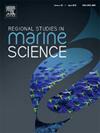Alpha and beta diversity patterns of the reef fishes’ early life stages and conservation implications in the Abrolhos Bank, Brazil
IF 2.1
4区 环境科学与生态学
Q3 ECOLOGY
引用次数: 0
Abstract
Coral reefs and associated habitats, such as mangroves, seagrass beds, and rhodolith beds, provide vital ecosystem services but are among the most threatened marine areas. This has led to a decline in the abundance of many reef-associated organisms, particularly coral reef fish. Understanding the dynamics of settlement and recruitment in reef fishes and their relationship with habitat is therefore essential for their conservation. Achieving ecosystem and species conservation objectives requires prioritizing areas with greater species richness and diversity, alongside those with higher densities of species threatened by exploitation at local and regional scales. In this study, we analyzed the alpha and beta diversity patterns of postlarval and juvenile coral reef fish in the Abrolhos Bank. Using light traps and underwater visual censuses (UVCs), we assessed diversity indices and decomposed beta diversity into turnover and nestedness components to explore spatial dynamics and habitat relationships. Our findings provide pioneering insights into the alpha and beta diversity patterns of postlarval and juvenile coral reef fishes in the Abrolhos Bank, revealing spatial variation in fish assemblages across sites. Beta diversity was predominantly driven by the turnover component, indicating significant species replacement between locations. Rhodolith beds and coastal reefs, such as Cassurubá and Paredes Parcel, were identified as critical habitats for maintaining fish stocks. We recommend prioritizing these areas in conservation strategies and promoting connectivity between them, considering the importance of larval input and recruitment for reef fish populations in the Abrolhos Bank.
求助全文
约1分钟内获得全文
求助全文
来源期刊

Regional Studies in Marine Science
Agricultural and Biological Sciences-Ecology, Evolution, Behavior and Systematics
CiteScore
3.90
自引率
4.80%
发文量
336
审稿时长
69 days
期刊介绍:
REGIONAL STUDIES IN MARINE SCIENCE will publish scientifically sound papers on regional aspects of maritime and marine resources in estuaries, coastal zones, continental shelf, the seas and oceans.
 求助内容:
求助内容: 应助结果提醒方式:
应助结果提醒方式:


